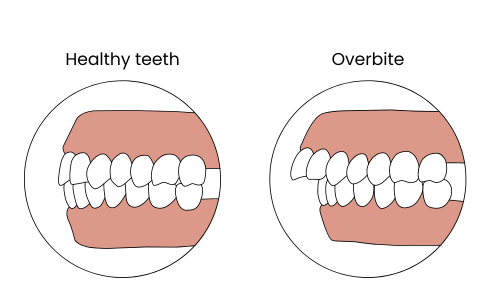What is an overbite? Correcting an overbite
This blog is a detailed exploration of overbites – a dental topic that many of us have heard about but might not fully understand.
In this blog post, we aim to demystify overbites, discuss their impact on oral health, and look into modern correction methods, with a special focus on Invisalign® and its remarkable results. Whether you’re just curious or actively seeking a solution, this guide is designed to provide clear, comprehensive, and helpful information.

What is an overbite?
An overbite is a common dental condition characterised by the upper front teeth significantly overlapping the lower front teeth. It’s a type of malocclusion – a fancy term for misaligned teeth or an irregular bite.
While a small degree of overbite is quite normal and doesn’t usually require treatment, a more pronounced overbite can lead to a variety of dental and health issues.
Overbite vs normal bite
It’s crucial to differentiate between a normal bite and an overbite.
In a normal bite, the upper front teeth overlap the lower teeth by about 1 to 2 millimetres. This slight overlap is perfectly normal and typically doesn’t cause any issues. However, when this overlap increases significantly (usually more than 4 millimetres), it’s classified as an overbite.
This is where potential problems can arise, and where treatment might be necessary.

Is overbite normal? When to seek treatment?
It’s worth reiterating that a minor overbite is a normal variation in dental anatomy. However, when the overbite is pronounced, or if it’s causing discomfort, speech issues, or affecting self-esteem, it’s advisable to seek professional advice.
Early intervention can prevent more complex issues in the future.
The impact of an untreated overbite
Neglecting an untreated overbite can lead to a range of challenges and complications that affect not just oral health but also overall well-being. These issues include:
1. Increased tooth wear
An overbite can create uneven pressure distribution during chewing, leading to excessive wear on the lower teeth. This wear and tear can accelerate tooth decay, potentially causing cavities and even tooth loss in more severe cases. The enamel, being worn down over time, can also lead to increased sensitivity to hot and cold foods, making eating an uncomfortable experience.
2. Jaw pain and TMJ disorders
When an overbite is present, it can disrupt the natural alignment of the jaw, placing additional stress on the jaw muscles and joints. This misalignment can lead to chronic jaw pain, discomfort, and sometimes more serious conditions like temporomandibular joint (TMJ) disorders. These disorders can manifest as pain or tenderness in the jaw, aching pain around the ear, difficulty chewing, and even locking of the joint, making it difficult to open or close the mouth.
3. Speech difficulties
An often-overlooked impact of an overbite is its potential effect on speech. The positioning of teeth plays a crucial role in the way we articulate sounds. An overbite can cause difficulties in pronouncing certain words, leading to lisping or other speech impediments. This can particularly affect children and may require speech therapy in addition to dental correction.
4. Eating challenges
Beyond speech and appearance, an overbite can make certain aspects of eating more challenging. Biting into foods can be difficult, and there might be an increased risk of biting the cheeks or tongue, leading to discomfort and sores in the mouth.
Correcting an overbite – traditional methods to modern solution
Traditional methods of correcting an overbite include braces and, in severe cases, corrective jaw surgery. However, advancements in dental technology have introduced more aesthetically pleasing and less invasive options like Invisalign®.
Invisalign® - a clear solution for overbite correction
Invisalign®, known for its clear and nearly invisible aligners, is a popular choice for correcting overbites, especially among adults and teenagers who are self-conscious about the appearance of traditional braces.
These custom-made aligners are not only discreet but also removable, making them a convenient option for many people.

Invisalign® overbite correction: the process
The process of correcting an overbite with Invisalign involves several steps:
Initial consultation: The journey begins with a consultation with a dental professional who assesses the overbite and discusses treatment goals.
Custom treatment plan: If Invisalign® is deemed suitable, a custom treatment plan is created using 3D imaging technology to map out the movement of the teeth.
Wearing the aligners: Patients receive a series of custom-made aligners, which they wear for about 20 to 22 hours per day, changing to a new set every one to two weeks.
Regular check-ups: Throughout the treatment, regular check-ups ensure progress is on track.
Conclusion
An overbite, while common, can range from a simple dental variation to a complex issue needing correction. Understanding the nuances of overbites and the advancements in treatment options, especially Invisalign®, can help you make informed decisions about your oral health. If you’re considering treatment options for an overbite, remember, it’s not just about achieving a beautiful smile; it’s also about improving your overall dental health and quality of life.
Are you experiencing an overbite? Contact us today and we can find out together the right treatment option for you!
FAQs
While Invisalign® is generally less painful than traditional braces, some discomfort is normal as the teeth move into their new positions.
There’s a small risk of teeth shifting back post-treatment. This is why wearing retainers as prescribed is crucial to maintain the results.
In many cases, correcting an overbite can subtly improve facial aesthetics by bringing the jaw into better alignment.
Early signs of an overbite may include noticeable protrusion of the upper front teeth over the lower teeth, difficulty in biting or chewing food, jaw pain, and sometimes speech difficulties like lisping. In children, habits such as thumb sucking can contribute to the development of an overbite.
Yes. Addressing an overbite often results in better oral hygiene. When your teeth are aligned as they should be, cleaning them becomes much simpler. This straightforward cleaning process significantly lowers the chances of developing common dental issues like plaque accumulation, gum disease, and tooth decay. Moreover, a properly aligned bite ensures that the biting force is distributed evenly across your teeth, contributing to a healthier mouth overall.
